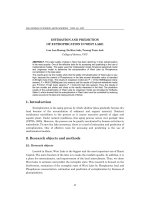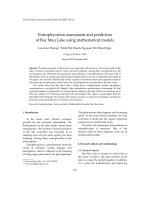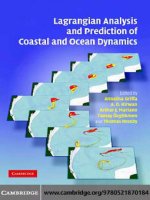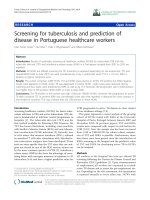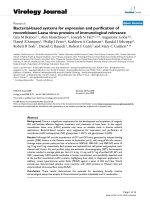Gaussian process based decentralized data fusion and active sensing agents towards large scale modeling and prediction of spatiotemporal traffic phenomena
Bạn đang xem bản rút gọn của tài liệu. Xem và tải ngay bản đầy đủ của tài liệu tại đây (1.23 MB, 132 trang )
GAUSSIAN PROCESS-BASED DECENTRALIZED DATA
FUSION AND ACTIVE SENSING AGENTS:
Towards Large-Scale Modeling and Prediction of Spatiotemporal
Traffic Phenomena
CHEN JIE
NATIONAL UNIVERSITY OF SINGAPORE
2013
GAUSSIAN PROCESS-BASED DECENTRALIZED DATA
FUSION AND ACTIVE SENSING AGENTS:
Towards Large-Scale Modeling and Prediction of Spatiotemporal
Traffic Phenomena
CHEN JIE
(M.Eng, Zhejiang University)
A THESIS SUBMITTED
FOR THE DEGREE OF DOCTOR OF PHILOSOPHY
DEPARTMENT OF COMPUTER SCIENCE
SCHOOL OF COMPUTING
NATIONAL UNIVERSITY OF SINGAPORE
2013
DECLARATION
I hereby declare that the thesis is my original work and it has been written by me
in its entirety. I have duly acknowledged all the sources of information which
have been used in the thesis.
This thesis has also not been submitted for any degree in any university previ-
ously.
—————————–
Chen Jie
16 August 2013
ACKNOWLEDGEMENTS
I appreciate and thank both my advisors Dr. Bryan Kian Hsiang Low and
Dr. Colin Keng-Yan Tan for the support, guidance, and advice throughout my
PhD candidature.
I am thankful to all friends from MapleCG group. My research benefited a
lot from the discussions with you.
I thank my colleague Cao Nannan for helping me in the implementation of
parallel Gaussian process together.
Many thanks to Professor Patrick Jaillet (MIT), Professor Lee Wee Sun
(NUS), Professor Leong Tze Yun (NUS), Professor Tan Chew Lim (NUS), Pro-
fessor David Hsu (NUS) and Professor Geoff Hollinger (OSU) for providing
invaluable feedbacks that improved my work.
I acknowledge Future Urban Mobility (FM) research group of Singapore-
MIT Alliance for Research and Technology (SMART) for sharing the high qual-
ity datasets and funding my research
1
.
I appreciate School of Computing, National University of Singapore for pro-
viding the facilities to run all my experiments.
Last, but not least, I would like to thank my wife Orange for the love, under-
standing, and support you gave me all these years. To my parents and family,
thank you for the encouragement, concern, and care.
1
Singapore-MIT Alliance Research and Technology (SMART) Subaward Agreement 14 R-
252-000-466-592
PUBLICATIONS
Parts of the thesis have been published in
1. Parallel Gaussian Process Regression with Low-Rank Covariance Matrix
Approximations. Jie Chen, Nannan Cao, Kian Hsiang Low, Ruofei Ouyang,
Colin Keng-Yan Tan & Patrick Jaillet. In Proceedings of the 29th Conference on
Uncertainty in Artificial Intelligence (UAI-13), pages 152-161, Bellevue, WA,
Jul 11-15, 2013.
2. Gaussian Process-Based Decentralized Data Fusion and Active Sensing for
Mobility-on-Demand System. Jie Chen, Kian Hsiang Low, & Colin Keng-Yan
Tan. In Proceedings of the Robotics: Science and Systems (RSS-13), Berlin,
Germany, Jun 24-28, 2013.
3. Decentralized Data Fusion and Active Sensing with Mobile Sensors for Mod-
eling and Predicting Spatiotemporal Traffic Phenomena. Jie Chen, Kian Hsiang
Low, Colin Keng-Yan Tan, Ali Oran, Patrick Jaillet, John M. Dolan & Gaurav
S. Sukhatme. In Proceedings of the 28th Conference on Uncertainty in Artificial
Intelligence (UAI-12), pages 163-173, Catalina Island, CA, Aug 15-17, 2012.
The other published work during my course of study:
4. Decentralized Active Robotic Exploration and Mapping for Probabilistic
Field Classification in Environmental Sensing. Kian Hsiang Low, Jie Chen,
John M. Dolan, Steve Chien & David R. Thompson. In Proceedings of the
11th International Conference on Autonomous Agents and MultiAgent Systems
(AAMAS-12), pages 105-112, Valencia, Spain, June 4-8, 2012.
Contents
List of Tables III
List of Figures IV
List of Symbols VI
1 Introduction 1
1.1 Motivation . . . . . . . . . . . . . . . . . . . . . . . . . . . . . 1
1.2 Objectives . . . . . . . . . . . . . . . . . . . . . . . . . . . . . 4
1.2.1 Accurate Traffic Modeling and Prediction . . . . . . . . 4
1.2.2 Efficiency and Scalability . . . . . . . . . . . . . . . . 4
1.2.3 Decentralized Perception . . . . . . . . . . . . . . . . . 5
1.3 Contributions . . . . . . . . . . . . . . . . . . . . . . . . . . . 6
1.3.1 Accurate Traffic Modeling and Prediction . . . . . . . . 6
1.3.2 Efficiency and Scalability . . . . . . . . . . . . . . . . 6
1.3.3 Decentralized Perception . . . . . . . . . . . . . . . . . 7
2 Related Works 9
2.1 Spatiotemporal Phenomena Modeling . . . . . . . . . . . . . . 9
2.2 Scaling Up Gaussian Process . . . . . . . . . . . . . . . . . . . 11
2.3 Data Fusion . . . . . . . . . . . . . . . . . . . . . . . . . . . . 12
2.4 Active Sensing . . . . . . . . . . . . . . . . . . . . . . . . . . 12
i
3 Modeling Spatiotemporal Traffic Phenomena 15
3.1 Gaussian Process . . . . . . . . . . . . . . . . . . . . . . . . . 15
3.2 Subset of Data Approximation . . . . . . . . . . . . . . . . . . 16
3.3 Modeling a Traffic Condition over Road Network . . . . . . . . 17
3.3.1 Relational Gaussian Process . . . . . . . . . . . . . . . 18
3.4 Modeling an Urban Mobility Demand Pattern . . . . . . . . . . 19
3.4.1 Log-Gaussian Process . . . . . . . . . . . . . . . . . . 20
4 Parallel Gaussian Process 22
4.1 Parallel Gaussian Process Regression using Support Set . . . . . 23
4.1.1 Parallel Gaussian Process: pPITC . . . . . . . . . . . . 23
4.1.2 Parallel Gaussian Process: pPIC . . . . . . . . . . . . . 25
4.1.3 Performance Guarantee . . . . . . . . . . . . . . . . . . 26
4.2 Parallel Gaussian Process Regression using Incomplete Cholesky
Factorization . . . . . . . . . . . . . . . . . . . . . . . . . . . 28
4.2.1 Parallel Incomplete Cholesky Factorization . . . . . . . 28
4.2.2 pICF-based Parallel Gaussian Process . . . . . . . . . . 29
4.2.3 Performance Guarantee . . . . . . . . . . . . . . . . . . 31
4.3 Analytical Comparison . . . . . . . . . . . . . . . . . . . . . . 32
4.3.1 Time, Space, and Communication Complexity . . . . . 32
4.3.2 Online/Incremental Learning . . . . . . . . . . . . . . . 33
4.3.3 Structural Assumptions . . . . . . . . . . . . . . . . . . 34
4.4 Experimental Setup . . . . . . . . . . . . . . . . . . . . . . . . 34
4.4.1 Settings . . . . . . . . . . . . . . . . . . . . . . . . . . 35
4.4.2 Performance Metrics . . . . . . . . . . . . . . . . . . . 36
4.5 Results and Analysis . . . . . . . . . . . . . . . . . . . . . . . 36
4.5.1 Varying Size of Data . . . . . . . . . . . . . . . . . . . 36
4.5.2 Varying Number of Machines . . . . . . . . . . . . . . 37
4.5.3 Varying Size of Support Set/Reduced Rank . . . . . . . 40
ii
4.5.4 Summary of Results . . . . . . . . . . . . . . . . . . . 41
5 Decentralized Data Fusion & Active Sensing 43
5.1 Decentralized Data Fusion . . . . . . . . . . . . . . . . . . . . 44
5.1.1 Gaussian Process-based Decentralized Data Fusion . . . 44
5.1.2 Gaussian Process-based Decentralized Data Fusion with
Local Augmentation . . . . . . . . . . . . . . . . . . . 47
5.2 Decentralized Active Sensing . . . . . . . . . . . . . . . . . . . 49
5.2.1 Problem Formulation . . . . . . . . . . . . . . . . . . . 50
5.2.2 Decentralized Posterior Gaussian Entropy Strategy . . . 51
5.2.3 Partially Decentralized Active Sensing . . . . . . . . . . 52
5.2.4 Fully Decentralized Active Sensing . . . . . . . . . . . 55
6 Decentralized Solution to Traffic Condition Monitoring 56
6.1 Motivation . . . . . . . . . . . . . . . . . . . . . . . . . . . . . 57
6.2 D
2
FAS Algorithm . . . . . . . . . . . . . . . . . . . . . . . . . 57
6.2.1 Time Complexity . . . . . . . . . . . . . . . . . . . . . 57
6.2.2 Communication Complexity . . . . . . . . . . . . . . . 59
6.2.3 Summary of Theoretical Results . . . . . . . . . . . . . 60
6.3 Experimental Setup . . . . . . . . . . . . . . . . . . . . . . . . 60
6.3.1 Settings . . . . . . . . . . . . . . . . . . . . . . . . . . 60
6.3.2 Performance Metrics . . . . . . . . . . . . . . . . . . . 62
6.4 Results and Analysis . . . . . . . . . . . . . . . . . . . . . . . 62
6.4.1 Predictive Performance & Time Efficiency . . . . . . . 62
6.4.2 Scalability . . . . . . . . . . . . . . . . . . . . . . . . 65
6.4.3 Varying length of walk . . . . . . . . . . . . . . . . . . 67
6.4.4 Summary of Empirical Result . . . . . . . . . . . . . . 69
7 Decentralized Solution to Mobility-on-Demand Systems 70
7.1 Motivation . . . . . . . . . . . . . . . . . . . . . . . . . . . . . 71
iii
7.2 D
2
FAS Algorithm . . . . . . . . . . . . . . . . . . . . . . . . . 72
7.2.1 Time Complexity . . . . . . . . . . . . . . . . . . . . . 73
7.2.2 Communication complexity . . . . . . . . . . . . . . . 74
7.2.3 Summary of Theoretical Result . . . . . . . . . . . . . 74
7.3 Experimental Setup . . . . . . . . . . . . . . . . . . . . . . . . 75
7.3.1 Settings . . . . . . . . . . . . . . . . . . . . . . . . . . 75
7.3.2 Performance Metrics . . . . . . . . . . . . . . . . . . . 77
7.4 Results and Analysis . . . . . . . . . . . . . . . . . . . . . . . 77
7.4.1 Performance . . . . . . . . . . . . . . . . . . . . . . . 77
7.4.2 Scalability . . . . . . . . . . . . . . . . . . . . . . . . 78
7.4.3 Summary of Empirical Result . . . . . . . . . . . . . . 80
8 Conclusion & Future Work 83
8.1 Contributions . . . . . . . . . . . . . . . . . . . . . . . . . . . 83
8.2 Future Directions . . . . . . . . . . . . . . . . . . . . . . . . . 85
Bibliography 87
Appendices 97
Appendix A Proof of Theorem 1 98
Appendix B Proof of Theorem 2 101
Appendix C Proof of Theorem 3 105
Appendix D Proof of Theorem 4 107
iv
Summary
Knowing and understanding the environmental phenomena is important to many
real world applications. This thesis is devoted to study large-scale modeling
and prediction of spatiotemporal environmental phenomena (i.e., urban traffic
phenomena). Towards this goal, our proposed approaches rely on a class of
Bayesian non-parametric models: Gaussian processes (GP).
To accurately model spatiotemporal urban traffic phenomena in real world
situation, a novel relational GP taking into account both the road segment fea-
tures and road network topology information is proposed to model real world
traffic conditions over road network. Additionally, a GP variant called log-
Gaussian process (GP) is exploited to model an urban mobility demand pattern
which contains skewness and extremity in demand measurements.
To achieve efficient and scalable urban traffic phenomenon prediction given
a large phenomenon data, we propose three novel parallel GPs: parallel par-
tially independent training conditional (pPITC), parallel partially independent
conditional(pPIC) and parallel incomplete Cholesky factorization (pICF)-based
approximations of GP model, which can distribute their computational load into
a cluster of parallel/multi-core machines, thereby achieving time efficiency. The
predictive performances of such parallel GPs are theoretically guaranteed to be
equivalent to that of some centralized approaches to approximate full/exact GP
regression. The proposed parallel GPs are implemented using the message pass-
ing interface (MPI) framework and tested on two large real world datasets. The
theoretical and empirical results show that our parallel GPs achieve significantly
I
better time efficiency and scalability than that of full GP, while achieving com-
parable accuracy. They also achieve fine speedup performance that is the ratio
of time required by the parallel algorithms and their centralized counterparts.
To exploit active mobile sensors to perform decentralized perception of the
spatiotemporal urban traffic phenomenon, we propose a decentralized algorithm
framework: Gaussian process-based decentralized data fusion and active sens-
ing (D
2
FAS) which is composed of a decentralized data fusion (DDF) compo-
nent and a decentralized active sensing (DAS) component. The DDF component
includes a novel Gaussian process-based decentralized data fusion (GP-DDF)
algorithm that can achieve remarkably efficient and scalable prediction of phe-
nomenon and a novel Gaussian process-based decentralized data fusion with lo-
cal augmentation (GP-DDF
+
) algorithm that can achieve better predictive accu-
racy while preserving time efficiency of GP-DDF. The predictive performances
of both GP-DDF and GP-DDF
+
are theoretically guaranteed to be equivalent
to that of some sophisticated centralized sparse approximations of exact/full
GP. For the DAS component, we propose a novel partially decentralized active
sensing (PDAS) algorithm that exploits property in correlation structure of GP-
DDF to enable mobile sensors cooperatively gathering traffic phenomenon data
along a near-optimal joint walk with theoretical guarantee, and a fully decen-
tralized active sensing (FDAS) algorithm that guides each mobile sensor gather
phenomenon data along its locally optimal walk.
Lastly, to justify the practicality of the D
2
FAS framework, we develop and
test D
2
FAS algorithms running with active mobile sensors on real world datasets
for monitoring traffic conditions and sensing/servicing urban mobility demands.
Theoretical and empirical results show that the proposed algorithms are signifi-
cantly more time-efficient, more scalable in the size of data and in the number of
sensors than the state-of-the-art centralized approaches, while achieving com-
parable predictive accuracy.
2
List of Tables
4.1 Comparison of time & space complexity between pPITC, pPIC,
pICF-based GP, PITC, PIC, ICF, and FGP. (Note that PITC, PIC,
and ICF-based GP are, respectively, the centralized counterparts
of pPITC, pPIC, and pICF, as proven in Theorems 1, 2 and 3.) . 33
4.2 Comparison of communication complexity between parallel GP
algorithms: pPITC, pPIC, pICF-based GP . . . . . . . . . . . . 34
III
List of Figures
1.1 The road network of Singapore with a large number 57848 of
road segments. . . . . . . . . . . . . . . . . . . . . . . . . . . 3
4.1 Performance of parallel GPs with varying data sizes |D| = 8000,
16000, 24000, and 32000, number M = 20 of machines, sup-
port set size |S| = 2048, and reduced rank R = 2048 (4096) in
the AIMPEAK (SARCOS) domain. . . . . . . . . . . . . . . . 38
4.2 Performance of parallel GPs with varying number M = 4, 8,
12, 16, 20 of machines, data size |D| = 32000, support set size
S = 2048, and reduced rank R = 2048 (4096) in the AIMPEAK
(SARCOS) domain. The ideal speedup of a parallel algorithm
equals to the number M of machines running the algorithm. . . 39
4.3 Performance of parallel GPs with data size |D| = 32000, num-
ber M = 20 of machines, and varying parameter P = 256,
512, 1024, 2048 where P = |S| = R (P = |S| = R/2) in the
AIMPEAK (SARCOS) domain. . . . . . . . . . . . . . . . . . 42
6.1 A real-world traffic phenomenon (speeds) over an urban road
network . . . . . . . . . . . . . . . . . . . . . . . . . . . . . . 61
6.2 Predictive performance (a-c) & time efficiency (d-f) vs. total no.
|D| of observations gathered by varying number K of mobile
sensors. . . . . . . . . . . . . . . . . . . . . . . . . . . . . . . 63
IV
6.3 Predictive performance (a-c) & time efficiency (d-f) vs. total no.
|D| of observations gathered by varying number K of mobile
sensors. . . . . . . . . . . . . . . . . . . . . . . . . . . . . . . 64
6.4 Time efficiency vs. total no. |D| of observations gathered by
varying number K of sensors. . . . . . . . . . . . . . . . . . . 66
6.5 Predictive performance (a-c) & time efficiency (d-f) vs. total no.
|D| of observations gathered by 2 mobile sensors with varying
length H of maximum-entropy joint walks. . . . . . . . . . . . 68
7.1 Historic demand and supply distributions obtained from a real
world taxi trajectory dataset in central business district of Sin-
gapore. . . . . . . . . . . . . . . . . . . . . . . . . . . . . . . 76
7.2 Performance of MoD systems in predicting and servicing mo-
bility demands. . . . . . . . . . . . . . . . . . . . . . . . . . . 79
7.3 Scalability of MoD systems in sensing and predicting mobility
demands. . . . . . . . . . . . . . . . . . . . . . . . . . . . . . 81
7.4 Scalability of MoD systems in servicing mobility demands. . . . 82
5
List of Symbols
Abbreviations
D
2
FAS
Gaussian process-based decentralized data fusion
and active sensing
DAS
decentralized active sensing
FDAS
fully decentralized active sensing
PDAS
partially decentralized active sensing
DDF
decentralized data fusion
GP-DDF
Gaussian process-based decentralized data fusion
GP-DDF
+
Gaussian process-based decentralized data fusion
with local augmentation
GP
Gaussian process
GP
log-Gaussian process
FGP
full/exact Gaussian process
PITC
partially independent training conditional approximation
of GP model
pPITC
parallel partially independent training conditional
approximation of GP regression
PIC
partially independent conditional approximation of
GP model
VI
pPIC
parallel partially independent conditional approximation
of GP regression
ICF
incomplete Cholesky factorization
pICF
parallel incomplete Cholesky factorization
SoD
subset of data approximation of GP
RMSE
root mean square error
KLD
Kullback-Leibler divergence
MoD
mobility-on-demand
Numbers
R
set of all reals
R
+
set of all positive reals
R
p
p-dimensional Euclidean space
K
number of mobile agents
K
number of connected components
κ
size of the largest connected component
M
number of parallel machines of a cluster
C
number of users in a MoD system
H
horizon of a planned walk
L
total length of an agent’s walk
R
the reduced rank
ε
a user-defined constant
Data
X
input domain
V
domain of road segments / regions
D
a set of observed inputs
U
a set of unobserved inputs
S
a set of support inputs / a subset of observed inputs
7
D
k
a set of observed inputs that is local to agent k
Y
s
random output variable of input s
y
s
realized output value (measurement) of input s
Z
s
log of random output variable of input s
z
s
log of realized output value (measurement) of input s
p(p
)
dimension of inputs
r
i
range of i-th feature of inputs
Functions
k(., .)
positive definite kernel function
m(.)
standardized Manhattan distance of an edge
d(., .)
shortest path distance between two vertex
g(.)
mapping from domain of road segments to Euclidean space
τ(.)
assignment function
log
logarithm to base e
H[.]
entropy of a probabilistic distribution
H[.]
approximation of Gaussian entropy
‹
H[.]
approximation of log-Gaussian entropy
max
maximum value of a function
arg max
argument of the maximum of a function
δ
ss
Kronecker delta
Vectors or Matrices
1
vector with all entries equal to one
I
identity matrix
A
T
transpose of matrix A
A
−1
inverse of matrix A
[.]
i
the i-th element of a vector
[.]
i,j
the element in row i and column j of a matrix
8
|.|
number of elements of a vector / determinant of a matrix
Gaussian Process
N(., .)
a Gaussian distribution
E[.]
prior mean of a random variable
cov[., .]
covariance function
σ
s
signal variance
σ
n
noise variance
i
characteristic length-scale of i-th feature of inputs
σ
ss
covariance
N(µ
U|D
, Σ
UU|D
)
posterior distribution of a full/exact GP
N(µ
U|S
, Σ
UU|S
)
posterior distribution of SoD approximation of GP
N(µ
PITC
U|D
, Σ
PITC
UU|D
)
posterior distribution of a PITC approximation of GP model
N(µ
PIC
U|D
, Σ
PIC
UU|D
)
posterior distribution of a PIC approximation of GP model
N(µ
ICF
U|D
, Σ
ICF
UU|D
)
posterior distribution of a PIC approximation of GP model
µ
GP
s|D
GP posterior mean
Decentralized Perception
G
graph representing road network or service area
E
edges of graph G
V
vertex of graph G
w
k
walk of agent k
W
k
set of all possible walk of agent k
w
∗
k
optimal walk of agent k
w
joint walk
w
∗
optimal joint walk
“
w
optimal joint walk obtained from PDAS
U
w
set of inputs induced by walk w
G
coordination graph
9
V
vertex of G representing agents
E
edges of G representing coordination dependencies among
agents
J
k
adjacency between agents
a
k
adjacency vector
A
G
adjacency matrix representing coordination graph
P
c
fleet distribution
P
d
historic demand distribution
N(
µ
U
,
“
Σ
UU
)
predictive distribution of GP-DDF / pPITC
N(
µ
+
U
,
“
Σ
+
UU
)
predictive distribution of GP-DDF
+
/ pPIC
( ˙y
k
S
,
˙
Σ
k
SS
)
local summary of agent k
(¨y
S
,
¨
Σ
SS
)
global summary in pPITC/pPIC/GP-DDF/GP-DDF
+
N(
µ
U
,
‹
Σ
UU
)
predictive distribution of pICF-based GP
( ˙y
m
,
˙
Σ
m
, Φ
m
)
local summary of machine m in pICF-based GP
(¨y,
¨
Σ)
global summary in pICF-based GP
F
upper triangular incomplete Cholesky factor
10
Chapter 1
Introduction
1.1 Motivation
Our modern world faces global issues such as non-renewable energy resources
depletion, human population explosion, and ecological environmental degrada-
tion. Confronted by these issues, in the Millennium Campaign
[
UNS, 2010
]
, the
United Nations called for the worldwide effort in reversing the loss of natural
resources and reducing the loss of biodiversity to ensure environmental sustain-
ability. Crucial to achieving this ambitious goal is the need to study, analyze and
understand the environmental phenomena spatiotemporally distributed over our
urban cities and natural habitats, such as
i. Urban Traffic Phenomena Sensing: The traffic phenomena such as traffic
speeds and volumes
[
Min and Wynter, 2011
]
, travel time along road segments
[
Hofleitner et al., 2012a; Herring et al., 2010
]
, congestion patterns
[
Hofleitner
et al., 2012b
]
, or travel demand
[
Powell et al., 2011
]
are studied in urban trans-
portation domain (Figures 6.1 & 7.1 illustrate real-world examples of traffic
speeds over road networks and mobility demand patterns, respectively). Know-
ing and using these phenomena at network level or user level, drivers can reduce
the time wasted (e.g., waiting time during congestion, cruising time of taxicabs
seeking customers) on traffic network, and consequently reduce the wastage of
fossil fuel and emission of air pollutants.
ii. Natural Phenomena Sensing: The natural phenomena such as the ocean and
fresh water phenomena (e.g., plankton bloom, anoxic zones, temperature, salin-
ity)
[
Low et al., 2012; Low et al., 2009c; Podnar et al., 2010; Dolan et al.,
1

